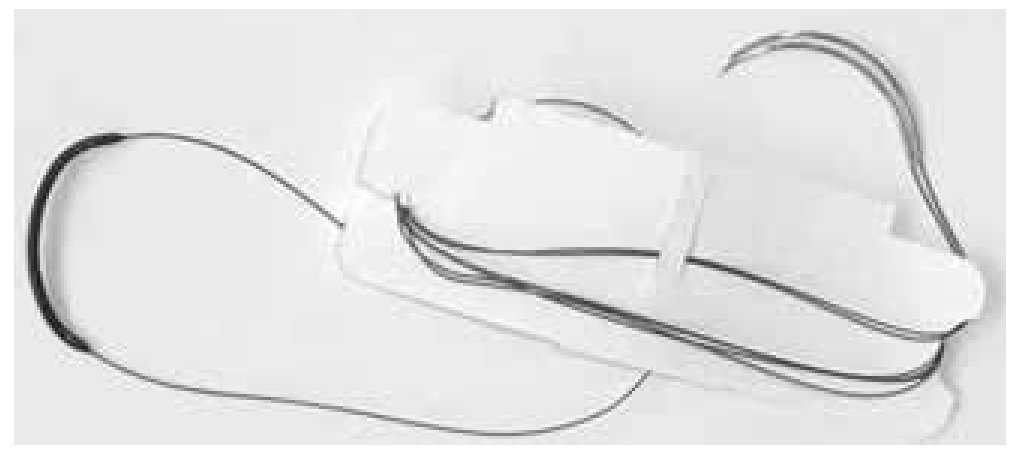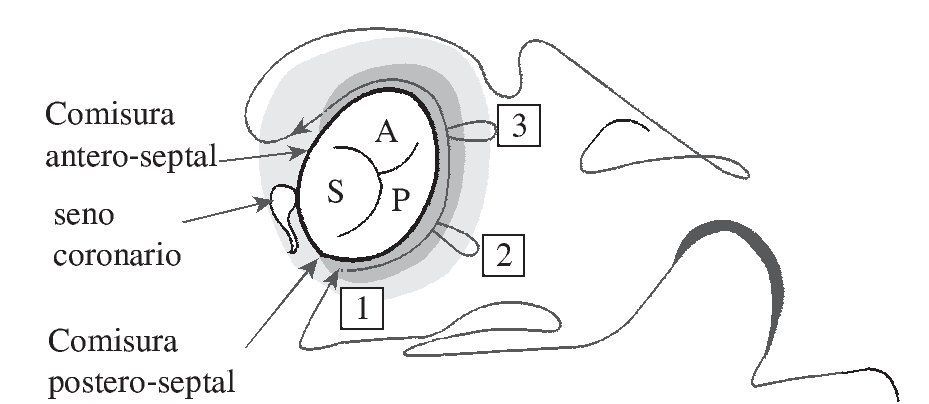ANULOPLASTIA TRICÚSPIDE CON ANILLO BIODEGRADABLE
El concepto de anillo biodegradable no es reciente. En 1983, el profesor Carpentier predijo el uso potencial de material biodegradable en la anuloplastia mitral1, y en 1990 su equipo llevó a cabo un programa experimental de reparación valvular mitral con el empleo de un anillo absorbible de polidioxanona, similar en forma al anillo rígido de Carpentier-Edwards2. En 1992, Duran describió los hallazgos histológicos de un estudio experimental en ovejas con el empleo de la anuloplastia tricúspide de De Vega utilizando una sutura de polidioxanona de 2-0. Este material de sutura permitió que el anillo tricúspide nativo permaneciera intacto durante los primeros tres meses y conservara sus dimensiones iniciales a los cinco meses tras la degradación parcial del anillo3.
La idea de reforzar temporalmente el anillo tricúspide usando material de sutura biodegradable fue posteriormente corroborada por Duran en un estudio clínico llevado a cabo en 73 pacientes con insuficiencia tricúspide (IT) funcional y baja resistencia pulmonar; la baja tasa de recurrencia de la IT durante un periodo de seguimiento de dos años mostró la estabilidad postoperatoria de dicha anuloplastia tricúspide4.
Aunque Carrier, et al. comunicaron de forma similar una baja tasa de fallo de la anuloplastia con buena supervivencia a largo plazo, tanto con las anuloplastias de De Vega, reductor lineal flexible de Bex o con anillo de Carpentier-Edwards5, muchos estudios clínicos han obtenido una mayor durabilidad de la reparación y una mejor supervivencia a largo plazo usando un anillo protésico comparado con la anuloplastia de De Vega o con la bicuspidización con sutura de la válvula tricúspide6-9.
En un estudio experimental sobre IT crónica que compara el uso de un anillo de politetrafluoroetileno (PTFE) totalmente flexible, un anillo de silicona elástico, un anillo rígido de metal y el no empleo de anillo, los patrones de motilidad anular fueron similares a los de un anillo normal cuando se emplearon los anillos de PTFE y silicona; sin embargo, solo el anillo de PTFE respetó la ondulación natural del anillo nativo, mientras que los otros dos anillos forzaron el plano tridimensional del anillo hacia una posición horizontal10.
El anillo biodegradable fue concebido y desarrollado con el objetivo de preservar la geometría dinámica tridimensional tanto del anillo tricúspide como del mitral. La versión tricúspide del anillo biodegradable de Kalangos® consta de un polímero de poli-1,4-dioxanona, dispuesto alrededor de un monofilamento de polivinilo 2-0 en continuidad a lo largo del anillo y equipado de una aguja de acero inoxidable en cada extremo (Fig. 1).
Figura 1. El anillo tricúspide biodegradable.
El peso molecular específico del material biodegradable asegura su flexibilidad tridimensional y memoria estructural frente a su deformidad posterior. La degradación gradual del material genera tejido fibroso, que produce a su vez un remodelado secundario y autólogo del anillo. De forma contraria a los anillos convencionales, el anillo biodegradable se implanta dentro del anillo nativo para promover la inflamación y su transformación secundaria en tejido fibroso.
La inserción intraanular del anillo evita la liberación de partículas procedentes de la degradación en el interior de las cavidades cardíacas. Para la anuloplastia tricúspide, el implante del anillo biodegradable empieza a nivel de la comisura posteroseptal (a 2-3 mm de la inserción del velo en el anillo y a 2-3 mm en profundidad) (Fig. 2.1), haciendo avanzar la aguja hacia delante y dentro del anillo hasta el primer punto de salida (Fig. 2.2). Reinsertando la aguja en el punto de salida y tirando del material de sutura, el anillo se adelanta hasta la comisura anteroseptal y se inserta completamente en el interior del anillo nativo. Se fija anudando cada uno de los dos extremos de la sutura a nivel de las comisuras anteroseptal y posteroseptal, respectivamente (Fig. 2.3)11.
Figura 2. 1. Primer punto de entrada del anillo en el anillo tricúspide nativo. 2. Primera salida y segundo punto de entrada del anillo. 3. Segunda y tercera entrada del anillo.
Normalmente, la inserción se completa tan solo con tres puntos. El anillo tricúspide biodegradable está disponible en tamaños pediátrico y adulto desde 16 a 36, igual que la versión mitral. El anillo biodegradable es especialmente ventajoso en la población pediátrica, ya que preserva la capacidad de crecimiento del anillo nativo y asegura un soporte duradero en posición tricúspide tal y como fue documentado por Mrowczynski, et al.12.
Se han publicado los resultados tempranos y a medio plazo de la anuloplastia tricúspide con anillo biodegradable comparados con los de la anuloplastia de De Vega13,14. El componente no degradable de la porción central del anillo evita la redilatación del anillo tricúspide al proporcionar una resistencia permanente frente a la distensión, jugando un papel esencial en la baja tasa de recurrencia de IT a lo largo del tiempo, como documentaron Basel, et al.14 y como apreciamos en nuestra experiencia no publicada. La flexibilidad tridimensional del anillo permite un implante rápido y sencillo, incluso por medio de cirugía mínimamente invasiva toracoscópica y robótica, como fue confirmado por Panos, et al. en una experiencia preliminar15.
La estructura biodegradable del anillo disminuye el riesgo potencial de infección15 en comparación con los anillos convencionales que contienen material sintético. El anillo biodegradable también elimina la necesidad de anticoagulación profiláctica, ya que su posición intraanular previene la interacción «sangre-material biodegradable»16.
Debido a las características ventajosas mencionadas anteriormente, el anillo biodegradable es una elección idónea para la anuloplastia tricúspide, al proporcionar un remodelado anular más fisiológico y duradero con la inducción de tejido fibroso antólogo.
AGRADECIMIENTOS
Me gustaría agradecer sinceramente a Dominique Vala su valiosa asistencia editorial.
Tricuspid Annuloplasty Using a Biodegradable Ring
TRICUSPID ANNULOPLASTY USING A BIODEGRABLE RING
The concept of a biodegradable ring is not a recent one. In 1983, Professor A. Carpentier predicted the potential use of biodegradable material for mitral annuloplasty1 and, in 1990, his team carried out experimental mitral valve repair with a polydioxanone absorbable ring, similar in shape to the rigid Carpentier-Edwards ring2. In 1992, Duran described histological findings in an experimental study on sheep with De Vega tricuspid annuloplasty using a 2-0 polydioxanone suture. This suture material allowed the native tricuspid annulus to remain intact during the first three months and conserved its initial dimensions at five months by partial ring degradation3. The idea of temporarily reinforcing the tricuspid annulus using biodegradable suture material was later corroborated by Duran, et al. in a clinical study carried out in 73 patients with functional tricuspid regurgitation and low pulmonary resistance; the low rate of recurrent tricuspid insufficiency over the follow-up period of two years reflected postoperative stability of the tricuspid annuloplasty4.
Although Carrier, et al. reported similar low failure rates and good long-term survival, be it with De Vega, Bex flexible linear reducer, or Carpentier-Edwards ring annuloplasties5, many clinical studies have obtained superior repair durability and long-term survival using a ring, as compared with De Vega annuloplasty or suture bicuspidization of the tricuspid valve6-9.
In an experimental study on chronic tricuspid regurgitation comparing the use of a totally flexible polytetrafluoroethylene (PTFE) ring, an elastic silicone ring, a rigid metal ring and no ring at all, patterns of annular motion were similar to that of a normal annulus with PTFE and silicone rings; however, only the PTFE ring respected the natural undulation of the native annulus, while the other two rings forced the tridimensional annular plane to become horizontal10.
The biodegradable ring was conceived and developed with the aim of preserving dynamic tridimensional geometry of the tricuspid as well as of the mitral annulus.
The tricuspid version of the Kalangos® biodegradable ring is comprised of a poly-1,4-dioxanone polymer, set around a 2-0 polyvinyl monofilament in continuity over the entire portion of the ring and equipped with a stainless steel needle at each extremity (Fig. 1).
The specific molecular weight of the biodegradable material ensures tridimensional flexibility and structural memory against subsequent deformity. The gradual degradation of the biodegradable material generates fibrous tissue, resulting in secondary autologous annular remodeling. Contrary to conventional rings, the biodegradable ring is implanted into the native annulus to promote inflammation and secondary transformation into fibrous tissue.
The intra-annular insertion of the ring prevents release of degraded particles into the cardiac cavities. For tricuspid annuloplasty, biodegradable ring implantation starts at the level of the postero-septal commissure (2-3 mm from the insertion of the leaflet on the annulus and 2-3 mm in depth) (Fig. 2.1), moving the needle forward into the annulus and up through the first exit point (Fig. 2.2). By reinserting the needle through the exit point and pulling up the suture material, the ring is thus advanced up to the antero-septal commissure and completely inserted into the native annulus, and fixed by tying each of the two suture extensions at the level of the antero-septal and postero-septal commissures, respectively (Fig. 2.3)11.
Insertion is usually completed after only three stitches. The tricuspid biodegradable ring is available in pediatric and adult sizes ranging from 16 to 36, just like the mitral version. The biodegradable ring is especially advantageous in the pediatric population as it preserves the growth potential of the native annulus and ensures durable support in the tricuspid position, as reported by Mrowczynski, et al.12.
Early and midterm results for tricuspid annuloplasty using the biodegradable ring have been published in comparison with the De Vega annuloplasty13,14. The non-degradable component of the central portion of the ring prevents re-dilatation of the tricuspid annulus by providing permanent resistance against tensile stretch, thus playing an essential role in the low rate of recurrent tricuspid insufficiency over time, as reported by Basel, et al.14 and as observed in our unpublished experience. The tridimensional flexibility of the ring allows for quick and easy implantation, even in minimally invasive thoracoscopic and robotic surgery, as confirmed by Panos, et al. in a preliminary experience15.
The biodegradable structure of the ring potentially decreases the risk of infection15 as opposed to conventional rings which contain synthetic material. The biodegradable ring also eliminates the need for prophylactic anticoagulation as its intra-annular position prevents all "blood-biodegradable material" interaction16.
Because of the advantageous characteristics mentioned above, the biodegradable ring is an optimal choice for tricuspid annuloplasty, providing for more physiological and durable annular remodeling with the induction of autologous fibrous tissue.
ACKNOWIEDGEMENT
I would like to sincerely thank Dr. Dominique Vala for her invaluable editorial assistance.
Correspondencia:
Afksendiyos Kalangos
Professor and Chairman
Division of Cardiovascular Surgery Hospital Universitario de Ginebra Medical School
Universidad de Ginebra Micheli-du-Crest, 24
CH-1211 Genève, Suiza
E-mail: Afksendyios.Kalangos@hcuge.ch
Recibido: 30 de septiembre de 2012
Aceptado: 5 de octubre de 2012









